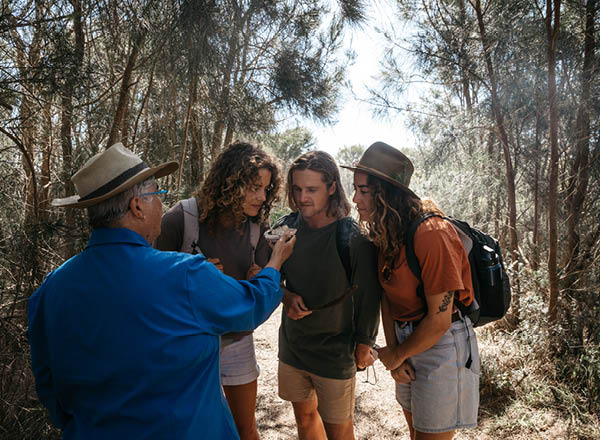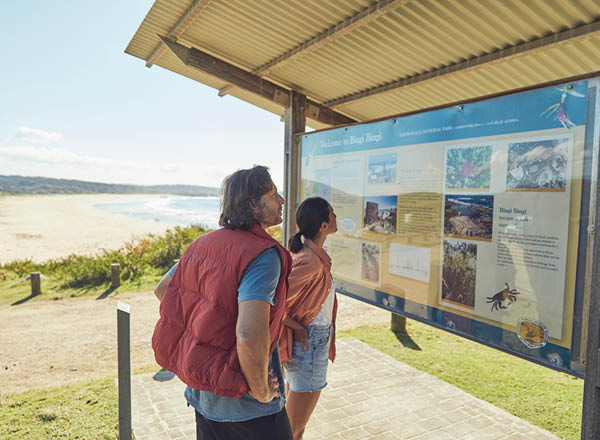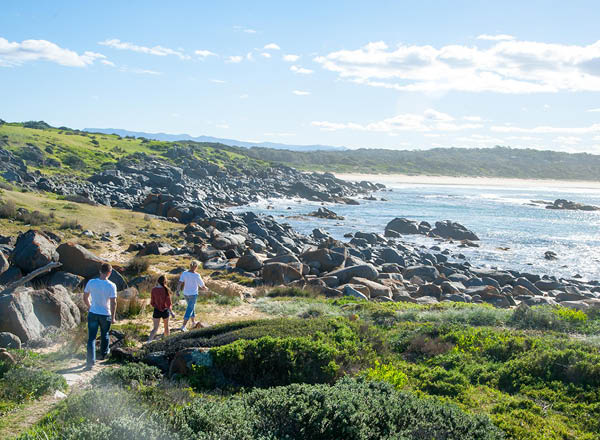Stretching 13.5km along the magnificent Eurobodalla coastline, from Congo in the north to Tuross Head in the south, the Bingi Dreaming Track is more than just a scenic coastal walk.
Tracing an ancient Songline of the Brinja-Yuin people, this trail located in Eurobodalla National Park is a deeply significant place for the area’s Traditional Aboriginal Custodians, whose ancestors have lived on the NSW South Coast for at least 20,000 years. Here’s how to make the most of it.

Take an Aboriginal-guided walk
Dreaming Tracks or Songlines are ancient Aboriginal wayfaring routes through the landscape that link campsites, ceremonial and trade sites, fresh water, food sources, and other significant sites. This knowledge is passed down through generations by story and song, and you can soak it up on a walking tour with Brinja-Yuin woman Patricia Ellis of Minga Cultural Experiences, who conducts fascinating walking tours on short sections of the Bingi Dreaming Track.
The remains of huge shell middens peeking through the grass at Bingie Bingie Point are the first sign that this place at the heart of the Bingi Dreaming Track was a popular spot for Yuin people to gather and feast, but Trisha will reveal so much more, such as how the middens were an early form of sustainable farming that taught visitors which seafoods should not be harvested in order to allow the environment to regenerate. Trisha will also show you how to identify local bush foods, medicine plants, and even stone artefacts, weaving together her ancestral knowledge with evocative Dreaming stories and softly-spoken historical truths about this special place.

Walk the track independently
The well-signposted Bingie Dreaming Track can be hiked from end to end in either direction in around four to six hours, with several access points along the Grade 3-rated trail (suitable for most ages and fitness levels) also making it possible to break up the walk into smaller sections. Typically traversed from north to south, the undulating, sometimes sandy track passes through different types of coastal habitat. There are great opportunities for birdwatching among the heathlands, forests and lakeshores, and you may see kangaroos and wallabies relaxing in the sun.
If you’re walking during whale watching season (May to November), be sure to stop off at one of the vantage points along the way for a glimpse of the majestic cetaceans, as well as panoramic views of Gulaga (Mount Dromedary) and Baranguba (Montague Island), which also have cultural significance to Yuin people. As you enjoy the scenery, remember to tread carefully, being sure not to disturb any artefacts you may stumble across, nor take any souvenirs aside from photos.

Tips for trail walkers
The Bingi Dreaming Track is open year-round, but always check the NSW National Parks and Wildlife Service website for current alerts before your visit. Spring is a particularly pleasant time of year to make the journey, when coastal banksias and a range of other wildflowers will be on display.
With limited shade along the track, adequate sun protection and drinking water are essential. There are no shops, restaurants or public toilets between the start and end points, so you’ll also need to bring your own snacks, as well as a rubbish bag to pack out everything you bring into the national park.
Parking is available at Congo village, Meringo, Bingie Bingie Point and Coila Beach. At Congo, the creekside national park campground is a scenic place to spend the night before you hit the trail. It has toilets, but you’ll need to bring everything else with you. If you haven’t left a car or pre-arranged a pick-up at Tuross Head, you can call a taxi to shuttle you back to your accommodation, or catch the Murrays Coaches service to Moruya (near Congo) that departs from Tuross Head Post Office at 2.15pm.
